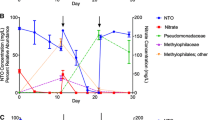Abstract
Four bacterial strains that use picric acid as their sole carbon and energy source were isolated. Mineralization of14C-UL-picric acid showed that up to 65% of the radioactivity was released as14CO2. HPLC and UV/Vis spectral analyses indicated complete degradation of picric acid by these organisms. HPLC and LC/MS analyses showed transient formation of 2,4-dinitrophenol during picric acid degradation. Degradation of picric acid was concomitant with stoichiometric release of three moles of nitrite per mole of picric acid. The four picric acid degraders were identified as close relatives ofNocardioides simplex (ATCC 6946) based on their small subunit (16S) rRNA gene sequences.
Similar content being viewed by others
References
Birnbaum D, L Herwaldt, DE Low, M, Nobel, M Pfaller, R Sherertz and AW Chow. 1994. Efficacy of microbial identification system for epidemiologic typing of coagulase-negative Staphylococci. J Clin Microbiol 32: 2113–2119.
Daniels L, RS Hanson and JA Philips. 1994. Chemical analysis. In: Methods for General and Molecular Biology (Gerhardt, P, RGE Murray, WA Wood and NR Krieg, eds), pp 514–554, American Society for Microbiology, Washington DC.
Duque E, A Haidour, F Godoy and JL Ramos. 1993. Construction of aPseudomonas hybrid strain that mineralizes 2,4,6-trinitrotoluene. Appl Environ Microbiol 175: 2278–2283.
Erikson, D. 1941. Studies on some lake-mud strains ofMicromodaspora. J Bacteriol 41: 277–300.
Gundersen K and HJ Jensen. 1956. A soil bacterium decomposing organic nitro-compounds. Acta Agric Scand 6: 100–114.
Gutell RR, B Weiser, CR Woese and HF Noller. 1985. Comparative anatomy of 16S-like ribosomal RNA. Prog Nucleic Acid Res Mol Biol 32: 155–216.
Lane DJ. 1991. 16S/23S rRNA sequencing. In: Nucleic Acid Techniques in Bacterial Systematics (Stackebrandt E and M Goodfellow, eds), pp 115–175, Wiley, New York.
Lenke H and H-J Knackmuss. 1992. Initial hydrogenation during catabolism of picric acid byRhodococcus erythropolis. Appl Environ Microbiol 58: 2933–2937.
Liesack W, H Weyland and E Stackebrandt. 1991. Potential risks of gene amplification by PCR as determined by 16S rDNA analysis of a mixed-culture of strict barophilic bacteria. Microbial Ecol 21: 191–198.
Maidak BL, N Larsen, MJ McCaughey, R Overbeek, GJ Olsen, K Fogel, J Blandy and CR, Woese. 1994. The ribosomal database project. Nucleic Acid Res 22: 3485–3487.
Maniatis T, EF Fritsch and J Sambrook. 1982. Molecular Cloning: A Laboratory Manual. Cold Springer Harbor Laboratory Press, Plainview, NY.
Marvin-Sikkema FD and JAM de Bont. 1994. Degradation of nitroaromatic compounds by microorganisms. Appl Microbiol Biotechnol 42: 499–507.
Olsen JG, H Matsuda, R Hagstrom and R Overbeek. 1994. fastDNAml: a tool for construction of phylogenetic trees of DNA sequences using maximum likelihood. CABIOS 10: 41–48.
Reysenbach A-L, GS Wickham and NR Pace. 1994. Phlogenetic analysis of the hyperthermophilic pink filament community in Octopus Spring, Yellowstone National Park. Appl. Environ Microbiol 60: 2113–2119.
Spain JC. 1995 Blodegradation of Nitroaromatic Compounds. Environmental Sciences Research, vol 49. Plenum Press, New York.
Woese CR, O Kandler and M Wheelis. 1990. Toward a natural system of organisms: proposal for the domains Archaea, bacteria and eucarya. Proc Natl Acad Sci USA 87: 4576–4579.
Wyman, JF, HE Guard, WD Won and JH Quay. 1979. Conversion of 2,4,6-trinitrophenol to a mutagen byPseudomonas aeruginosa. Appl Environ Microbiol 37: 222–226.
Author information
Authors and Affiliations
Additional information
This is contribution 7167 from Central Research & Development, Dupont Co, Wilmington, DE 19880, USA
Rights and permissions
About this article
Cite this article
Rajan, J., Valli, K., Perkins, R.E. et al. Mineralization of 2,4,6-trinitrophenol (picric acid): Characterization and phylogenetic identification of microbial strains. Journal of Industrial Microbiology 16, 319–324 (1996). https://doi.org/10.1007/BF01570041
Received:
Accepted:
Issue Date:
DOI: https://doi.org/10.1007/BF01570041




